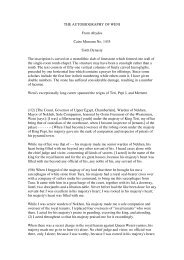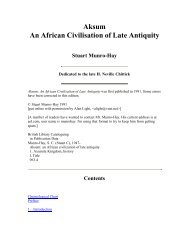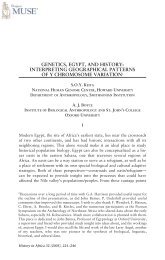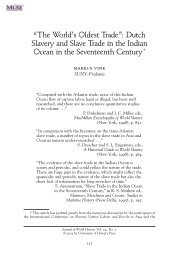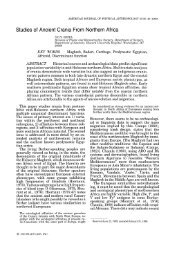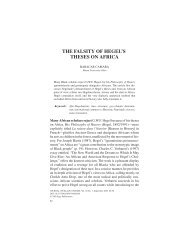The Negro trail blazers of California [microform] : a ... - Homestead
The Negro trail blazers of California [microform] : a ... - Homestead
The Negro trail blazers of California [microform] : a ... - Homestead
Create successful ePaper yourself
Turn your PDF publications into a flip-book with our unique Google optimized e-Paper software.
OF CALIFORNIA 27<br />
<strong>of</strong> which and a Concordate <strong>of</strong> April 7, 1772, between the authorities <strong>of</strong> the two orders<br />
sanctioned by the Viceroy, the Missions <strong>of</strong> Lower <strong>California</strong> were confided to the Dominicans<br />
and those <strong>of</strong> Upper <strong>California</strong> to the Franciscans.<br />
"<strong>The</strong> income and product <strong>of</strong> the Pious Fund were hereafter applied to the Missions<br />
<strong>of</strong> both orders. <strong>The</strong> Church, when first established in Upper <strong>California</strong>, was purely missionary<br />
in its character. It first dates from 1769, in July <strong>of</strong> which year Fr. Junipero<br />
Serra, a Franciscan Friar, and his companions reached the port <strong>of</strong> San Diego overland<br />
from the frontier Missions <strong>of</strong> Lower <strong>California</strong> and then foundeil the first Christian Mission<br />
and the first settlement <strong>of</strong> civilized men within the territory comprising what is now the<br />
State <strong>of</strong> <strong>California</strong>. <strong>The</strong> Missions were designed so that, when the population should be<br />
sufficiently instructed, to be converted into parish churches and maintained as such, as had<br />
already been done in other parts <strong>of</strong> the Viceroyalty <strong>of</strong> New Spain.<br />
"But in the meantime and while the necessary missionary character continued, they<br />
were under the ecclesiastical government <strong>of</strong> a President <strong>of</strong> the Mission. Fr. Junipero<br />
Serra was the first who occupied that <strong>of</strong>fice and the Missions were governed and directed<br />
by him and his successors as such down to the year 1836, when the authority <strong>of</strong> this <strong>of</strong>fice<br />
was superseded by the appointment <strong>of</strong> a bishopric or diocese. Francis Garcia Diego, the<br />
last President <strong>of</strong> the Missions, was the first bishop <strong>of</strong> the new diocese <strong>of</strong> Upper <strong>California</strong>.<br />
"<strong>The</strong> text <strong>of</strong> the decree <strong>of</strong> pragmatic sanction expelling the Jesuits from the Spanish<br />
domain is very brief. Under this provision the Crown took all the estate <strong>of</strong> the order into<br />
its possession, including those <strong>of</strong> the Pious Fund, but later constituting a trust estate,***<br />
charged with this trust. This was fully recognized by the Crown, and the property <strong>of</strong> the<br />
Pious Fund, so held in trust, was afterwards managed in its name by <strong>of</strong>ficers appointed<br />
for the purpose, called a Junta Directive.<br />
"This income and product continued to be devoted through the instrumentality <strong>of</strong><br />
the ecclesiastical authorities to the religious uses for which they were dedicated by the<br />
donors.***On the declaration <strong>of</strong> Mexican Independence, Mexico succeeded to the Crown<br />
<strong>of</strong> Spain as trustee <strong>of</strong> the Pious Fund, and it continued to be managed and its income<br />
applied as before down to September 19, 1836, when the condition <strong>of</strong> the Church and the<br />
Missions established in <strong>California</strong> seemed to render desirable the erection <strong>of</strong> the country<br />
into a diocese or bishopric for its government.***<br />
"<strong>The</strong> two <strong>California</strong>s. Upper and Lower, were erected by His Holiness, Pope Gregory<br />
XVI into a diocese and Francis Garcia Diego, who until that time had been President <strong>of</strong><br />
the Missions <strong>of</strong> Upper <strong>California</strong>, was made bishop <strong>of</strong> the newly constituted See. As<br />
such he became entitled to the administration, management and investment <strong>of</strong> the Pious<br />
Fund as a trust.<br />
***"0n February 8, 1840, so much <strong>of</strong> the law <strong>of</strong> September 19, 1836, as confided the<br />
management and investment <strong>of</strong> the fund to the bishop was abrogated by a decree <strong>of</strong> Santa<br />
Ana, the President <strong>of</strong> the Eepublic, and the trust was again devolved on the State, but<br />
that decree did not purport in any way to impair or alter the rights <strong>of</strong> the trust. On the<br />
contrary, it merely devolved on the Government the investment and money <strong>of</strong> the Pious<br />
Fund.***On October 24, 1842, another decree was made by the same President,*** directing<br />
that the property belonging to the Pious Fund should be sold for the sum represented<br />
by its income capitalized on the basis <strong>of</strong> 6% per annum,*** and that the proceeds <strong>of</strong> the<br />
sale as well as the cash investment <strong>of</strong> the funds should be paid into the public treasury<br />
and recognized as an obligation on the part <strong>of</strong> the Government to pay annually there<strong>of</strong><br />
thenceforth. '<br />
<strong>The</strong> reader has learned from the quotation <strong>of</strong> extracts from the paper by Mr.^ Doyle<br />
that the missionary fathers financed their own establishment <strong>of</strong> the <strong>California</strong> Missions,<br />
through the income derived from the Pious Fund. This paper fully stated the banishment<br />
from Mexico <strong>of</strong> the Jesuit Order <strong>of</strong> missionaries. <strong>The</strong> reason for allowing the Franciscan<br />
Order to do such wonderful work in laying the foundation for civilizing the <strong>California</strong>ns<br />
is explained by Father Engelhardt, who says: "When the royal decree expelling the<br />
Jesuits from New Spain had been executed, Viceroy de Croix and Inspector General Jose<br />
de Galvez resolved to place the <strong>California</strong> Missions in charge <strong>of</strong> the Franciscan Mission<br />
College <strong>of</strong> San Fernando, in the City <strong>of</strong> Mexico. ***<strong>The</strong>re were still some Jesuit Friars in<br />
the Missions <strong>of</strong> Lower <strong>California</strong>. <strong>The</strong> Crown sent Captain Gaspar de Portolo, a Castilian,<br />
to execute the Koyal decree in <strong>California</strong>. He was at the same time made Governor<br />
<strong>of</strong> the Peninsula <strong>of</strong> <strong>California</strong>. Don Gaspar de Portolo sailed from Spain with<br />
fifty soldiers and fourteen Franciscans."<br />
Seven years previous there also had sailed from "Spain August 28, 1749, Fr. Junipero<br />
Serra, a Franciscan, and Francisco Palou, who came to the College <strong>of</strong> San Fernando,<br />
in Mexico City, arriving in January, 1750." <strong>The</strong>se two Friars were anxious to Christianize<br />
the heathen in <strong>California</strong>.


![The Negro trail blazers of California [microform] : a ... - Homestead](https://img.yumpu.com/32436613/31/500x640/the-negro-trail-blazers-of-california-microform-a-homestead.jpg)

